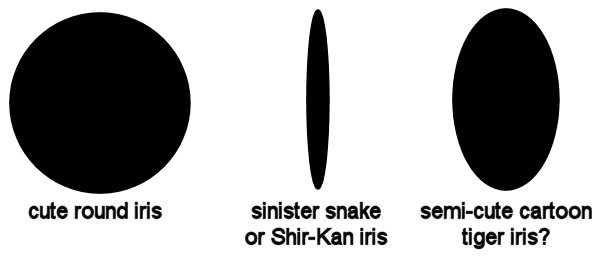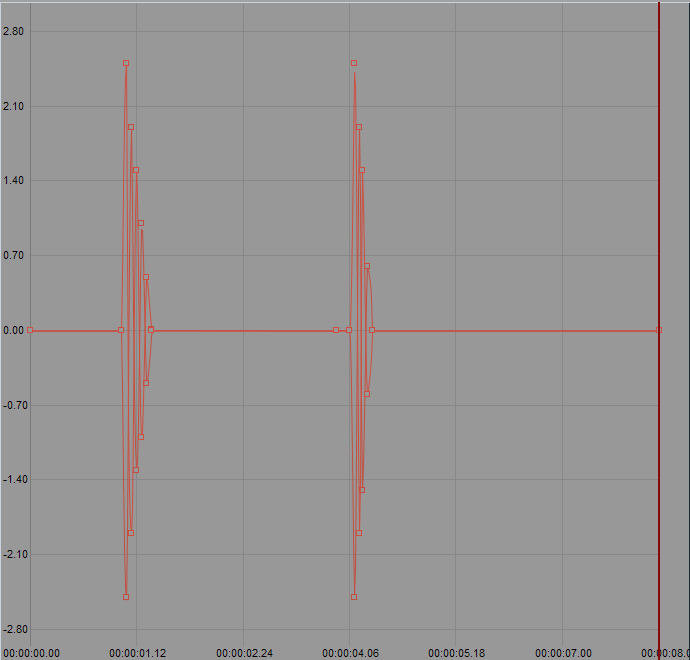
cstanton
*A:M User*-
Posts
179 -
Joined
-
Last visited
Content Type
Profiles
Forums
Events
Everything posted by cstanton
-
-
Stian, These models are excellent. It looks like the deck railing is penetrating the pontoon of the airplane facing the viewer. [attachmentid=21877] Curtis
-
Uh-oh, I may be getting into a bit of self-analysis here. This is strictly my opinion and my response to the image: To me, the round irises are cute and lend a suggestion of innocence to the character. They seem slightly incongruous for a tiger. If that's the effect you're after, it could be interesting and round irises are fine. In my mind, tigers have an essence of mysterious majesty about them and the impression of cute innocence dilutes that quality. [attachmentid=20593] Curtis
-
Unless it was an artistic decision to have round irises, he might look better with elliptical cat irises. They'd match his stripes. Curtis
-
It's been fun and my pleasure, Curtis
-
Cory, I lowered the pitch of the thud portion of the footsteps without preserving their duration, which blends them together a little and, I think, makes the rhythm of the initial steps less obvious. I also reduced the volume of the first thuds. Bug Voice, Steps & Music (H.264--2.06MB) I don't know what sample rate you prefer so I've again included uncompressed 44.1 kHz and 48 kHz files: Audio Track (44.1 kHz--3.61MB) Audio Track (48 kHz--3.9MB) Curtis
-
Cory, I hear sort of a "shave and a haircut" kind of rhythm to the first stomps before the bug raises himself. I think it detracts from the sinister nature of the clip. I could add a little more base to the thump portion of the steps and lower the volume even more before he puts his full weight on his legs. It might blur the effect somewhat. Curtis
-
You could try selecting Reset Settings, a menu item in the Help Menu. It will change most of your preferences back to the default settings, but it also sometimes restores blank rotoscopes. Here's another thread on the subject with additional possible solutions: Blank Rotoscope Thread You can also try switching from DirectX to OpenGL or visa versa. Curtis
-
Cory, The footsteps in this version are a little more subtle. Tweaked the music a little and mixed a little thunder with the music at the end of the video--I thought it might help transition to the credits and kind of book end the thunder when he rises to the top of the frame close to the beginning. Bug Voice, Steps & Music (H.264--2.06MB) This is probably not the final version, but I've also included an uncompressed WAV file of this version: 48kHz, 16 bit stereo. You should be able to download it (right click the link and select "save link as..." or "copy to folder," however your browser phrases its download function) and import it into Premier. It should sync with the video when the beginning of the audio clip is aligned with the beginning of the video clip. The audio tracks in your editor might default to 44.1 kHz which might throw it out of sync, but you should be able to change the sample rate of the audio tracks. Bug Audio (WAV file--3.93MB) I'm open to changes and suggestions, but I'll be out of town again from sometime tomorrow afternoon until Monday night. Curtis EDIT: I've added a 44.1 kHz WAV file Bug Audio (44.1 kHz WAV file 3.61MB)
-
Cory, This is the first pass of the complete sound track. I added a few footsteps for the bug's left legs for steps that I couldn't see. I allowed the heart beat music to continue for 10 seconds past the video to allow for a musical background for the closing credits. Complete Sound Track (H.264--2.1MB) Does the footstep pattern sound too much like a typewriter? I could increase the volume on the clicking portion of the steps or tone down the thumps, or both. Curtis
-
OK, finally, the bug voice, 1st pass, without the watermark H.264 (1.84MB) (onward and upward)
-
Cory, This is the first pass at the bug voice. Bug Voice 4.56MB (H.264) It's been one of those days and I didn't get as much done as I'd hoped. On top of everything else, my editor regressed to a demo version for some reason, may have been a MS update or something, don't know. Anyway, I'm posting this first pass of the voice for comment with an Avid watermark dead center. I'm told I have to repair or re-install the software, probably re-install, to re-register. I'll back-up everything and do that tomorrow (big sigh.) Curtis
-
Cory, I just wanted to let you know that I started on your audio track this morning. There are three tracks to the bug voice; I finished the first track and started the second. I have to switch to some "real word" stuff. I should be able to get back to the voice tracks later this afternoon (Pacific time.) I hope to have the first pass of the voice, footsteps and music tracks all posted sometime this evening. Curtis ps: nice dool
-
Cory, I just saw this clip--it looks great--I'd be glad to re-do the audio. Is this the SIGGRAPH version? I assume you'd like it pretty much the way it was including a music track? Would you like me to create the closing credits? If so what is the final format and compression? I won't be able to get to it until later this week, but I'll try to have the first version done by this weekend at the latest. When do you have to turn it in? Curtis
-
One more suggestion based on personal preference: I use Sound Forge 7 (they're now up to version 8) for audio effects and Acid Pro for music and mixing. They both can handle audio effects; Acid Pro can handle unlimited tracks while Sound Forge can only handle a single track of stereo or mono. Sound Forge has the advantage of being able to apply effects to a segment of any length on the track rather than to the whole track. There is also Sound Forge Audio Studio 8 and Screen blast Sound Forge which are less expensive. Sony Audio Products Acid Pro is a loop based music creation program that provides lots of flexibility, but you are on your own when it comes to finding the appropriate loops and building multiple tracks of loops, one shots and beat mapped clips to create your masterpiece. It can be fun. Both programs allow you to import a video clip so you can sync your audio to the video. Sonicfire Pro 4 by Smartsound is another type of music creation program that is designed specifically for adding music tracks to video. It uses music tracks that are actually complete pieces that are broken into segments so you can create your own arrangements and variations. The music can be lengthened or shortened and it always preserves a proper beginning and ending. The CDs of music tracks are a little expensive, but you can buy single tracks online. The program assembles all of your music tracks into a library that is divided into various categories that makes it very easy to find what you're looking for. You can ask it to list only the tracks you own or all of the tracks online as well. You can listen to samples of the online tracks and buy them on the spot through the program--very artsy/capitalistic. The advantage of Sonicfire over a loop based program like Acid Pro is that the music can be stretched or squashed to match your video scene--very cool--and much faster than working with Acid Pro. The advantage of Acid Pro is that you have much greater flexibility in "composing" your own music. The program has the ability to change the beat of a track to match the entire piece and you can change the beat of the entire piece to match the video. It can also change the "groove" from, say, 16th note swing to blues, hip hop, funk, jazz, etc. Acid Pro 6 includes a media management data base and is more sophisticated than previous versions in helping you to manage your musical components. I also use Acid Pro to add voice over and effects (usually created in Sound Forge) to the audio track. Acid Pro has the ability to record, but I usually record and edit in Sound Forge because of its greater flexibility of being able to work with segments of a track and it's very easy to see what you're doing on the wave form with only a single track taking up the entire screen. And, if you're recording voice over or whatever in a home studio, Sound Forge has very effective noise reduction software. You can find lots of free sound effects on line. Find Sounds is a good place to start. They allow you to search for keywords by minimum resolution and minimum sample rate. I usually start with a high resolution and sample rate and then lower them if I can't find what I'm looking for. Google for "free sound effects" and you'll find lots more sites. Acid Pro comes with something like 1,000 loops and a number sound effects one shots, some of which you can play from a soft synth keyboard. Curtis
-
Cory, I made a few minor changes to the camera shake version: no new action or effects, but I synced the music to the video a little better and cleaned-up the double yelp in the second screech (I wanted to see if I could shorten the screeches enough to fit and still preserve the pitch and avoid artifacts.) I thought you might want to check it out, in case you were planning on using some of this footage in the final version. QuickTime H.264 (2.8MB) I'm curious about the format you'll be using for the final version. The version I've been playing with is just about 24 seconds long, 640x480. Uncompressed it weighs in at 846 MB (887,751,296 bytes). I've been interested in distributed or collaborative production using the Internet to transfer files, but I've never done it, have you? I'm very interested in how the TWO project will handle this. I just rendered some test versions at best quality, H.264 compression out of curiosity. Of course the HD versions were rendered from a compressed SD file so they are distorted and aren't true HD, but the file sizes were what I was interested in. (23;28 seconds, 30fps, progressive): 1080p HD version, 1920x1080, is 73.8 MB (77,479,936 bytes) 720p HD version, 1280x720, is 38.7 MB (40,591,977 bytes) DV version, 720x486, is 19.7 MB (20,705,473 bytes) I also did an HDV/MPEG2 test, 720p, the file is 33.1 MB (34,769,526 bytes) My NLE is supposed to be able to edit long GOP MPEG2 files in their native format, if that would be useful; I've never tried it. The 1080p version would be just manageable for me. We'd only need to send the full resolution version twice. All the evaluation transfers could be much more compressed. Also, 30 seconds of 1080p would be about all I'd want to edit with my single 2.4GHz HT processor, HD is really a dual processor, dual core task. Much more than 30 seconds would be a life sentence for my computer. You may have this all pinned down. If so, I apologize for rambling, Curtis
-
Luckbat, That URL seems to have a close parenthesis that shows up in the error msg "The requested URL /TinCan/AM_&_Alpha.htm) was not found on this server." Alpha Stuff Thanks for the link, Curtis
-
Also, the tripod is not very imposing when viewed from tripod "eye level." It would be more intimidating if viewed from human eye level. You might consider an "establishing shot" that includes the tripod and Thom in the same frame, probably from an angle closer to Thom so the shot by the tripod is aimed, more or less, in the camera's direction. And why is Thom lying down before he's shot? Curtis
-
I'm not an expert. More like a trial & error guy having fun with some great toys, including A:M. Curtis
-
I use Avid Liquid for video editing and some simple audio mixing and editing; Sound Forge for audio editing and FX; and, in this case, Acid Pro for music loops and mixing. I sometimes use SonicFire Pro for music. Curtis
-
Cory, I didn't know if this previz clip of the creature knocking over the camera and closing the shot with static would be helpful or not. It's a somewhat crude 2D modification of your existing 3D footage. I can't really drop the camera to the ground, but, I guess the main thing I got from it was that it might be useful to have the bug hit the camera more than once before the camera shuts down (maybe a close-up leg kicking it in the process of marching toward the operator and over the camera as it lies on the ground.) Bug & Static (Windows Media 3.2MB) (Compression really messes up the video noise.) I also did a flashlight thing with a film-look nighttime filter and mask. Again, a crude 2D simulation. The previz doesn't get the shadows right--which would be the main point of low angle, eerie lighting. The thing I learned here is that the herky-jerky flashlight has to always delay and then lag behind the head movement (I didn't get it right towards the end, but left it in.) I think shaking the light as it dims during an EverReady moment lets the viewer know it's just a flashlight, the guy holding it is ill-equipped, he's been caught by surprise, and things are not going well. Bug Light (Windows Media 2.9MB) I'm just having fun with this stuff; I realize it may not match your concept--or be possible in the time you have left--offered strictly for what it's worth. Curtis
-
Cory, This is the tail slap and camera shake experiment. It was obvious to me that the tail caused the crashes even though it was obscured when it hit the ground. But I was expecting it; I'm not sure that it would be obvious to a viewer watching for the first time and probably focusing on the head. QuickTime H.264 (2.8MB) This is the x,y position chart of the image within the frame that I used for the camera shake. If you like the camera shake, it would be better to add it in A:M. I have to enlarge the image slightly to keep the edges of the moving image outside the frame when I do it in post. But if you're pressed for time on the final version, I can do it in post. Anyway, if you like it, this might serve as a starting point. I just used x,y; I didn't use any rotation. I moved the x and y coordinates in opposite directions for each key frame just to make it easier to see what I was doing on the graph. [attachmentid=16993] Stuff like the lightning effect was relatively easy to do in post and much faster than setting up lights in A:M (at least for me.) I modulated the second screech quickly and not very effectively (volume in the nle) but it's now buried by the tail smash. The thuds of the footsteps are still there when I turn off the music track, but they must be the same pitch as the music, interestingly the higher pitched footstep clicks, which are lower volume, come though fine. I guess that's it for this version, unless you have some suggestions, or until you make changes. Curtis
-
Cory, Oops, fixed the spelling of your name and re-posted to the same file. The Boston SIGGRAPH conference is 30 July to 3 August, the exhibition is 1 to 3 August. Curtis
-
Cory, OK, one more idea. . . well, a couple more. AVI (8.9MB) QT (9.3MB) This is just a rough cut test. All the previous effects are unchanged. Waddaya think? [ ] Well, not too bad (considering) [ ] Nope, nope, nope -- not now, not ever [ ] Stop bothering me BTW, all the audio & video stuff is royalty free so you can show it or post it anywhere. Curtis
-
Cory, I agree about the second screech; it does need to be modulated and the base track needs to be blended in more. I hesitate to make any suggestions concerning your animation, but I had this idea: As I watched the clip I was itching to add a little camera shake in my video editor. I thought about adding a crash when the creature smashes its tail into the ground. But, it might be just too much racket in an 8 second clip, and it wasn't entirely clear that the tail did hit the ground. I didn't want the viewer to think a gaffer had knocked over a light stand. But, it might be worth a try. If you think this would be worth experimenting with, I could just add a couple more footstep thumps and amp them up a little for now. Adding a little camera shake to go with the bigger tail thumps would be easy to do in the NLE. If the experiment looks good, the actual clip should probably have the tail more visible when it hits the ground the first time so the viewer will know what's causing the crash. After the first crash, the tail smash can be obscured as long as the viewer can see the tail rising up and starting down. Just some thoughts, Curtis Late night edit: What if he actually knocks over the camera at the end?



